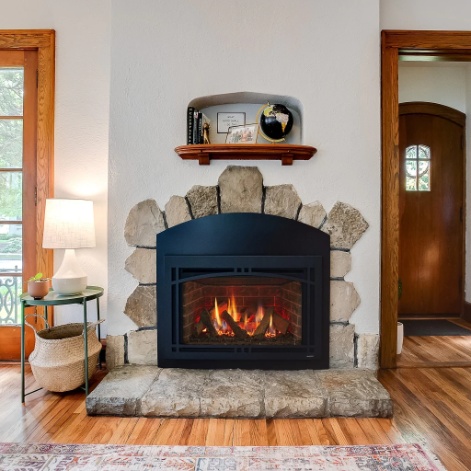Table of Contents
Gas fireplaces are a popular choice for homeowners looking to add warmth and ambiance to their living spaces. When deciding on a gas fireplace, one important consideration is whether or not to opt for a blower. Understanding the differences and benefits of a gas fireplace blower versus no blower can help you make an informed decision.
Introduction
A gas fireplace blower is a device that helps distribute the warm air generated by the fireplace throughout the room. This supplementary component can significantly improve the heating efficiency of the fireplace. By blowing the warm air into the room, it ensures that the heat is evenly distributed. This allows for a cozy and comfortable environment.
On the other hand, a gas fireplace without a blower does not have this additional feature. Instead, it relies on the natural convection process, where the warm air rises and spreads throughout the room.
There are advantages and disadvantages to both options. A gas fireplace without a blower is often quieter, as there is no fan noise. It also tends to be less expensive, as there are no additional components required. However, it may not distribute heat as efficiently and effectively as a fireplace with a blower.
A gas fireplace with a blower provides improved heating efficiency, allowing for faster heat distribution and potentially reducing energy costs. However, it may produce some noise due to the operation of the blower.
Several factors should be considered when choosing between a gas fireplace blower and no blower. Heating efficiency is a crucial factor, as a blower can help maximize the heat output. Noise level is another consideration, particularly if the fireplace is located in a quiet space. Cost, including both initial investment and potential energy savings, should also be taken into account. Installation and maintenance requirements should be evaluated as well.
By weighing the pros and cons of a gas fireplace blower and no blower, considering your specific needs and preferences, you can determine which option is best suited for you.
Gas Fireplace Blower: What is it and How Does it Work?
A gas fireplace blower is an accessory that enhances the functionality of a gas fireplace. It improves heat distribution throughout the room. Here’s how it works:
A gas fireplace blower consists of a fan or blower unit that is connected to the fireplace’s venting system. When the gas fireplace is turned on, the blower unit draws in cool air from the room and pushes it through a heat exchanger or a series of tubes that are heated by the gas flame.
As the cool air passes through the heat exchanger, it gets heated up and then expelled back into the room through the blower unit’s vents. This process helps to circulate warm air more effectively, allowing for better heat distribution and a more comfortable environment.
Some gas fireplace blowers come with variable speed settings, allowing you to adjust the airflow according to your preference. This gives you greater control over the amount of warm air distributed and the noise level produced by the blower.
It is important to note that not all gas fireplaces come with a blower as a standard feature. Some models offer the option to add a blower as an accessory, while others do not support a blower unit at all.
The decision to use a gas fireplace blower ultimately depends on your specific needs and preferences. If you desire more efficient heat distribution and a warmer room, a blower can be a beneficial addition to your gas fireplace setup. If you are satisfied with the heat output and distribution provided by your fireplace without a blower, it may not be necessary for you.
Before purchasing a gas fireplace blower, ensure that it is compatible with your specific gas fireplace model and consult the manufacturer’s guidelines for installation instructions.
Related Article: How to Clean and Maintain Your Fireplace Blower for Maximum Performance
What Does a Gas Fireplace Blower Do?
A gas fireplace blower is an essential component that helps to improve the efficiency and performance of a gas fireplace. What does a gas fireplace blower do? Here are some key functions of a gas fireplace blower:
- It circulates heat: A gas fireplace blower is responsible for distributing warm air throughout the room. It helps to circulate the heated air efficiently and evenly, ensuring that the room remains warm and comfortable.
- It increases heat output: By blowing the heated air into the room, a gas fireplace blower enhances the heat output of the fireplace. This means that the room can be heated faster and more effectively than without a blower.
- It improves heating efficiency: With a blower, the heat generated by the gas fireplace is not wasted. Instead, it is directed into the room, maximizing the heating efficiency of the fireplace.
- It reduces heat loss: A gas fireplace blower prevents heat loss by pushing the warm air away from the fireplace and into the room. This helps to maintain a consistent temperature and prevents the air from becoming stagnant around the fireplace.
- It enhances comfort: By effectively circulating and distributing warm air, a gas fireplace blower creates a more comfortable environment in the room. It eliminates cold spots and ensures that everyone can enjoy the warmth from the fireplace.
A gas fireplace blower plays a crucial role in increasing the efficiency, heat output, and overall comfort provided by a gas fireplace. It is an important consideration for anyone looking to maximize the benefits of their gas fireplace.
How Does a Gas Fireplace Blower Work?
A gas fireplace blower, also known as a gas fireplace blower fan or a gas fireplace heat exchanger, is a device that operates by circulating warm air from the fireplace into the room, thereby enhancing the heating efficiency. Its mechanism involves using a fan to draw in cool air from the surrounding area and then pushing it through a heat exchanger, where the air gets heated through the combustion of gas. The heated air is subsequently blown back into the room, resulting in a more efficient and evenly distributed heat dispersion process.
It is important to understand that fireplace blowers do not increase the BTUs produced by the fireplace. Instead, it increases the efficiency of the fireplace forcing air into the room or space.
To control the gas fireplace blower, there is typically a switch or thermostat provided, enabling the user to adjust the airflow’s speed and intensity. This feature plays a crucial role in regulating the temperature and maximizing the comfort level within the room.
When considering the use of a gas fireplace blower, it is important to take into account the noise level it may generate. Although the blower effectively distributes heat, it can produce some operational noise. However, modern gas fireplace blowers are specifically designed to operate more quietly, ensuring a peaceful and cozy atmosphere in your home.
During installation and ongoing maintenance, one must carefully consider certain factors. Some models may necessitate professional installation, while others can be easily installed by homeowners themselves. Regular maintenance tasks like cleaning the blower and checking for potential blockages are essential for maintaining optimal performance.
No Blower: Pros and Cons
Choosing whether to opt for a gas fireplace without a blower can have its own set of pros and cons. On one hand, enjoying the warmth and ambiance of a gas fireplace without the noise and maintenance of a blower can be enticing. It’s important to consider the advantages and disadvantages carefully before making a decision. In the following sections, we will explore the benefits and drawbacks of a gas fireplace without a blower, providing you with valuable insights to help you determine if it’s the right choice for you.
Advantages of a Gas Fireplace without a Blower
- Quiet operation: A gas fireplace without a blower offers the advantage of operating silently, creating a peaceful and relaxing environment in your home.
- No additional energy consumption: The absence of a blower in a gas fireplace means that it doesn’t rely on electricity to function. This brings the advantage of no extra energy consumption, resulting in lower electricity bills.
- Simplicity: Gas fireplaces without blowers have the advantage of a simpler design and operation, making them easier to maintain and repair. There are no moving parts or motors to worry about.
- Lower cost: As a result of their simpler design, gas fireplaces without blowers are usually more affordable compared to models with blowers. This advantage makes them a cost-effective option for homeowners on a budget.
- Less maintenance: The absence of a blower means there are no air filters to clean or replace. This reduces maintenance tasks and associated costs, thereby offering a maintenance advantage.
- Ambiance: Gas fireplaces without blowers still provide the cozy and warm ambiance of a traditional fireplace, without the noise and forced air movement. This advantage ensures a pleasant atmosphere in your home.
Disadvantages of a Gas Fireplace without a Blower
There are several disadvantages of a gas fireplace without a blower:
- Limited Heat Distribution: Without a blower, the heat from the gas fireplace is not effectively circulated throughout the room. This can result in uneven heating, leaving certain areas colder than others.
- Lower Heating Efficiency: Gas fireplaces without blowers have lower heating efficiency compared to those with blowers. The lack of a blower reduces the amount of heat that is distributed and can lead to wasted energy.
- Slower Warm-up Time: Without a blower, it can take longer for the room to reach the desired temperature. The heat generated by the fireplace will need to naturally radiate into the room, resulting in a slower warm-up time.
Pro-tip: If you choose a gas fireplace without a blower, consider using additional methods such as ceiling fans or portable heaters to help distribute the heat more evenly throughout the room. This can help overcome some of the limitations of a fireplace without a blower.
Gas Fireplace with Blower: Pros and Cons
Enhance the warmth and efficiency of your gas fireplace with a blower. Discover the pros and cons awaiting you as we weigh the advantages and disadvantages of a gas fireplace equipped with this powerful addition. From increased heat distribution to potential noise concerns, we’ll delve into the details that will help you decide if a gas fireplace with a blower is the ultimate choice for your cozy haven.
Advantages of a Gas Fireplace with a Blower
- Gas fireplaces with blowers offer several advantages, including improved heat distribution, increased heating efficiency, faster heat delivery, reduced heating costs, and customizable heating levels.
- One of the advantages of a gas fireplace with a blower is its improved heat distribution. The blower helps to evenly distribute the heat throughout the room, ensuring that all areas can benefit from the warmth.
- In addition to improved heat distribution, a gas fireplace with a blower also achieves higher heating efficiency. The blower circulates the warm air, reducing heat loss and maximizing the effectiveness of the fireplace in warming the room.
- A blower allows for quicker heat delivery compared to a fireplace without one. The warm air is pushed out immediately, providing comfort and warmth to the room in a shorter period of time.
- Moreover, a gas fireplace with a blower can help to reduce heating costs. By improving heat distribution and increasing heating efficiency, the heat is better utilized and distributed, ensuring that less energy is wasted.
- Additionally, some gas fireplaces with blowers offer adjustable speed settings for the blower. This allows users to control the amount of warmth and airflow in the room, providing customizable heating levels based on personal preferences.
True History
In the early 1900s, gas fireplaces emerged as a more convenient alternative to traditional wood-burning fireplaces. However, they were limited in their ability to effectively distribute heat throughout the room. Recognizing this limitation, innovators developed the gas fireplace blower, which revolutionized the efficiency of gas fireplaces.
The addition of a blower transformed gas fireplaces into more than just decorative features. These blowers, powered by electricity, propelled the warm air produced by the gas flames into the surrounding space, ensuring that every corner of the room would experience the cozy warmth. This advancement not only increased the efficiency of gas fireplaces but also made them a practical heating solution for many households.
Today, gas fireplaces with blowers remain a popular choice for homeowners. The advantages of these fireplaces, such as improved heat distribution, increased heating efficiency, faster heat delivery, reduced heating costs, and customizable heating levels, make them an attractive option for those seeking both warmth and comfort in their homes.
Disadvantages of a Gas Fireplace with a Blower
Increased noise: One of the main disadvantages of a gas fireplace with a blower is the amplified noise level it produces. The blower can generate noticeable amounts of noise, which might be bothersome for individuals seeking a tranquil evening by the fireplace.
Additional cost: The installation of a gas fireplace with a blower usually incurs an extra expense. Apart from purchasing and setting up the blower itself, there is a rise in the overall expenditure of the fireplace due to the need for electricity to run the blower, which can also lead to increased energy costs.
Potential maintenance issues: Regular maintenance is necessary for ensuring the blower in a gas fireplace functions optimally. This includes cleaning, checking for malfunctions, and replacing parts if necessary. The maintenance requirements contribute to the overall upkeep of the fireplace.
Less uniform heat distribution: Despite the blower being designed to evenly distribute heat, it may not always achieve this objective. Depending on the room layout and blower positioning, certain areas may receive less heat or experience temperature fluctuations.
Reliance on electricity: A gas fireplace with a blower depends on electricity to power the blower. In the event of a power outage, the blower will not function, potentially making the fireplace less efficient in heating the room.
Considering these drawbacks, it is crucial to carefully consider the pros and cons before deciding on a gas fireplace with a blower. If a quiet atmosphere, lower overall cost, or reduced maintenance are priorities, opting for a gas fireplace without a blower may be more suitable. However, if heat distribution and efficiency are significant factors, choosing a fireplace with a blower could be the right option. Ultimately, the decision should be based on individual preferences and specific needs.
Factors to Consider When Choosing Between a Gas Fireplace Blower and No Blower
When it comes to deciding between a gas fireplace blower and having no blower, there are several important factors to consider. We’ll dive into these factors, such as heating efficiency, noise level, cost, and installation and maintenance. So, whether you’re looking for maximum warmth or peace and quiet during those cozy nights by the fire, we’ve got you covered with all the information you need to make the right choice for your home.
Heating Efficiency
When it comes to choosing between a gas fireplace blower and no blower, heating efficiency is an important factor to consider. Here are some key points to keep in mind:
- Energy savings: A gas fireplace with a blower can significantly improve heating efficiency by circulating warm air throughout the room. This can help distribute heat evenly and reduce the amount of energy needed to keep the space warm.
- Increased heat output: The presence of a blower can increase the heat output of a gas fireplace. This means that the room can reach a desired temperature more quickly and efficiently.
- Heat distribution: A blower helps to distribute heat more evenly, ensuring that every corner of the room receives warmth. This can lead to greater overall comfort and a more pleasant heating experience.
- Quick heating: With a blower, the warm air from the fireplace is pushed out into the room at a faster rate. This can result in faster heating of the space, allowing you to enjoy the cozy ambiance of a fireplace without having to wait for an extended period of time.
A gas fireplace with a blower can significantly improve heating efficiency by increasing heat output, distributing heat more evenly, and providing faster heating. These factors can result in energy savings and increased comfort in your home.
Noise Level
The noise level is an important factor to consider when choosing between a gas fireplace blower and no blower.
- Gas Fireplace Blower: A gas fireplace with a blower can produce noise due to the operation of the blower fan. The noise level can vary depending on the quality and design of the blower system.
- Noise Reduction: Some gas fireplace blowers are designed to minimize noise levels. These blowers often feature noise-reducing technologies or insulation to dampen the sound produced.
- Perceived Noise: The perception of noise can vary from person to person. While some individuals may find the noise of a blower comforting or soothing, others may find it distracting or disruptive.
- No Blower: Gas fireplaces without a blower generally produce less noise since there is no fan operating. It’s important to note that other factors in the fireplace, such as gas flow or ignition, may still generate some noise.
- Noise Considerations: Consider your preference for ambient noise in the room where the fireplace will be installed. If you prefer a quiet and peaceful atmosphere, a gas fireplace without a blower may be more suitable.
- Personal Sensitivity: Some individuals may be more sensitive to noise than others. If you are particularly sensitive to noise or have specific noise-related concerns, it is recommended to test the noise levels of different gas fireplace models before making a final decision.
- Manufacturer Specifications: When researching gas fireplaces, check the manufacturer’s specifications for noise levels or any noise reduction features. This can help you make an informed decision based on the noise level that best suits your preferences.
Cost
The cost of a gas fireplace blower is an important factor to consider when deciding whether to install one in your fireplace. Here is a table outlining the average costs associated with gas fireplace blowers:
| Gas Fireplace Blower Cost | Range |
|---|---|
| Blower Unit | $100 – $300 |
| Installation | $200 – $500 |
| Operating Costs | Approximately $5 – $10 per month |
| Maintenance | Varies depending on the type of blower, typically $50 – $100 per year |
The cost of a gas fireplace blower can vary depending on factors such as the brand, quality, and the complexity of the installation process. The blower unit itself typically ranges from $100 to $300, while installation costs can be between $200 and $500.
In terms of operating costs, a gas fireplace blower typically consumes electricity to power the fan. On average, it may add around $5 to $10 per month to your electricity bill.
Maintenance costs for a gas fireplace blower can also vary. It is recommended to have the blower serviced annually. This can cost around $50 to $100, depending on the type of blower and any necessary repairs.
When considering whether a gas fireplace blower is worth the cost, it’s important to weigh the added comfort and efficiency it provides against the initial purchase and ongoing maintenance costs. Ultimately, the decision will depend on your budget and heating needs.
Installation and Maintenance
When it comes to the installation and maintenance of a gas fireplace, there are a few important steps to consider:
- Ensure that the gas fireplace is installed by a qualified professional to guarantee safety and proper function.
- Regularly clean the fireplace and its components to prevent the buildup of debris, dust, and soot. This will help maintain its efficiency and prolong its lifespan.
- Inspect the gas fireplace annually to check for any potential issues or damage. This will ensure that it continues to operate safely and efficiently.
- If there are any signs of malfunction or problems with the gas fireplace, such as unusual smells or difficulty igniting, contact a professional technician for repairs.
- When performing maintenance, always follow the manufacturer’s instructions and guidelines to avoid any damage to the fireplace or harm to yourself.
- Keep the area around the gas fireplace clear of any flammable materials and ensure proper ventilation to prevent the risk of fire or carbon monoxide poisoning.
- Regularly replace the batteries in the fireplace’s remote control or thermostat to ensure smooth operation.
By following these installation and maintenance steps, you can ensure that your gas fireplace remains in good condition and provides warmth and comfort for years to come.
Frequently Asked Questions
1. Should I install a blower for my gas powered fireplace?
Yes! Installing a blower for your gas powered fireplace can help circulate hot air. It also distributes heat more evenly throughout the room.
2. Will using a gas fireplace without a blower increase my gas bill?
No, using a gas fireplace without a blower will not directly increase your gas bill. However, the blower can help make the room heat faster and more efficiently, potentially reducing overall heating costs.
3. Are thermostatically controlled blowers available for gas fireplaces?
Yes, there are gas fireplace blowers with built-in thermostats. These blowers automatically adjust the speed based on the temperature, providing more comfort and relaxation.
4. Can a blower be added to a previously installed gas fireplace?
Yes, it is possible to add a blower to a previously installed gas fireplace. However, make sure to check the compatibility and installation requirements with the manufacturer or consult a professional service technician.
5. Are ventless gas fireplaces compatible with blowers?
No. Ventless gas fireplaces should not be used with blowers. The lack of proper ventilation can lead to exhaust buildup. It is important to adhere to the manufacturer’s guidelines for each specific model.
6. Can a blower make my gas fireplace too hot?
While a blower helps circulate hot air, it is designed to distribute heat evenly without making the fire excessively hot. It is important to ensure the blower is compatible with the fuel type. It is also important to properly install to avoid any potential safety issues. Contact the experts at Dreifuss Fireplaces today!
Latest Articles

What Is An NG (Natural Gas) Indicator And Why You Need It For Your Fireplace
Table of Contents1 Understanding Natural Gas Fireplaces2 What is an NG Indicator?3 Importance of NG Indicators for Safety4 Types of NG Indicators5 Installation and Maintenance of NG Indicators6 Signs of a Faulty NG Indicator7 Frequently Asked Questions Natural gas fireplaces are a favored option among numerous homeowners due to their convenience and effectiveness. But, what is an NG (Natural Gas) indicator and why you need it for your fireplace? It is imperative to comprehend how they function and the significance of having an NG (Natural Gas) indicator for safety purposes. This article delves into the definition and significance of NG indicators. We will discuss the potential hazards associated with the absence of one and the various types of indicators accessible. Also, we will discuss installation and maintenance recommendations, and methods to recognize and rectify issues with malfunctioning indicators. Stay well-informed and ensure the safety of your home by referring to this exhaustive guide. Understanding Natural Gas Fireplaces Natural gas fireplaces serve as an efficient and convenient heating option for numerous households. They utilize natural gas as a fuel source to deliver consistent warmth and ambiance. How They Work and Why They Need NG Indicators The operation of natural gas fireplaces involves igniting natural gas to generate heat. This process requires diligent monitoring to ensure both safety and efficiency, a task facilitated by the use of NG indicators. NG indicators play a critical role in detecting potential gas leaks. They enable residents to promptly address and mitigate any associated hazards. Through continuous monitoring of gas levels and providing timely warnings and alerts, NG indicators uphold a secure indoor environment. It is imperative to ensure that these indicators function properly to facilitate the effective operation of natural gas fireplaces. This helps mitigate the inherent risks linked to gas leaks. What is an NG Indicator? An NG indicator is a specialized device equipped with advanced sensors and technology. It is specifically designed to detect natural gas leaks and monitor gas pressure in appliances, such as fireplaces. Definition and Purpose The NG indicator functions as a detector that monitors gas appliances for potential leaks. It provides essential functionality to ensure safety in households utilizing natural gas. These detectors play a crucial role in protecting residences by notifying occupants of dangerous gas leaks long before they escalate into perilous situations. Through continuous monitoring of gas levels in the vicinity, NG indicators offer an additional layer of protection. This is particularly important in properties that rely on gas-operated fireplaces or stoves. These devices not only help avert potential disasters but also enhance the overall peace of mind of homeowners. They assure them that their living spaces are equipped with reliable safety features. Importance of NG Indicators for Safety Natural gas indicators are essential for maintaining safety in households equipped with natural gas appliances. These devices serve as a proactive measure to promptly detect gas leaks. This offers homeowners a sense of security and assurance. Potential Dangers of Not Having an NG Indicator The absence of an NG indicator in residences equipped with natural gas appliances can pose significant hazards. This includes the risk of undetected gas leaks , carbon monoxide poisoning , and pilot outages that may lead to dangerous situations. These potential risks can profoundly impact indoor air quality. They directly influence the health and safety of individuals residing in the household. Undetected gas leaks can go unnoticed, gradually permeating the air and creating a potentially explosive environment. Insufficient ventilation from undetected exposure to carbon monoxide can lead to serious health complications. These range from mild symptoms such as dizziness to fatal poisoning. Without proper monitoring from an NG indicator, families are left susceptible to these concealed threats. This underscores the critical importance of implementing proactive measures to mitigate such risks. Types of NG Indicators Indicators for Natural Gas (NG) are available in diverse types. Each presents distinct detection capabilities tailored to specific requirements, encompassing both manual and automated alternatives. Manual vs. Automatic Indicators Manual NG indicators require user intervention for monitoring gas levels and identifying leaks. On the other hand, automatic indicators employ sophisticated technology to deliver continuous, real-time monitoring. This heightened efficiency and oversight enhance safety protocols. Conventional manual indicators rely on individuals to physically inspect and evaluate gas levels periodically. This renders them more susceptible to human errors. Conversely, automatic indicators feature sensors capable of promptly detecting even the most minute fluctuations in gas levels. This establishes a more dependable and precise monitoring mechanism. Automatic indicators can activate alerts and shut-off systems upon detecting a leak. This ensures immediate action to avert potential hazards. This advanced technology enhances safety protocols and instills a sense of command and assurance among users. Installation and Maintenance of NG Indicators The reliable and accurate performance of NG indicators necessitates proper installation and consistent maintenance. This often entails professional installation and adherence to recommended service guidelines. Proper Installation and Regular Maintenance Tips The proper installation of NG indicators involves adhering to the specifications in the user manual. Maintenance protocols entail strict adherence to a predetermined maintenance schedule to ensure sustained operational efficiency. During the installation phase, it is imperative to verify that the NG indicators are securely affixed in the designated location as stipulated by the manufacturer. Crucial steps include confirming power source compatibility and ensuring proper grounding of the device to optimize performance. Calibration of the indicator must be executed meticulously to ensure precise readings. Regarding maintenance, essential practices include regular inspection for signs of wear, thorough cleaning of the indicator components, and routine functionality tests. By allocating time to a consistent maintenance regimen, the NG indicator can operate with optimal efficiency over an extended duration. Signs of a Faulty NG Indicator Recognizing indicators of a malfunctioning NG indicator is essential for upholding safety and performance standards. Inaccuracies and detection issues can undermine the efficacy of these devices. Identifying and Addressing Issues The process of identifying and addressing issues related to NG (natural gas) indicators requires a systematic troubleshooting approach. This ensures their optimal performance

What You Need To Know About Gas Log Set Safety And Installation Considerations
Table of Contents1 Understanding Gas Log Sets2 Safety Considerations for Gas Log Sets3 Installation Guidelines for Gas Log Sets4 Maintaining and Troubleshooting Gas Log Sets5 Frequently Asked Questions Gas log sets are a favored option among homeowners seeking to enjoy the comfort and atmosphere of a conventional fireplace without the inconvenience of wood. This article tells you what you need to know about gas log set safety and installation considerations. Before incorporating one into your residence, it is imperative to understand the safety considerations associated with their use. This discussion delves into the potential hazards linked with gas log sets. It presents crucial precautions to uphold the safety of your home. Also, it outlines proper installation procedures and offers insight into common errors to avoid. Finally, it provides advice on maintenance and troubleshooting. Gain comprehensive knowledge on gas log set safety and installation considerations. Understanding Gas Log Sets Comprehending gas log sets is essential for individuals seeking to elevate their fireplace experience, and for gas lag set safety and installation. These heating appliances can operate on either natural gas or propane. In addition, they are available in a range of styles, including vented, ventless, and vent-free options. They provide an array of benefits and customization opportunities through various fireplace accessories. What are Gas Log Sets? Gas log sets are meticulously crafted artificial logs. They are designed to imitate the appearance and functionality of authentic wood logs within fireplaces. These gas log sets typically consist of ceramic or refractory concrete logs that have been skillfully molded and painted. This allows them to replicate the natural grain and texture of real wood. The logs are arranged in various configurations within the fireplace. They establish a realistic and welcoming ambiance. In addition to the logs, gas log sets often include fireplace accessories such as glowing embers. Accessories also include decorative stones, and even pine cones to enhance the overall aesthetic appeal. Homeowners can select from an array of placement options. These include traditional wood stack, cascading driftwood, or a contemporary geometric arrangement. Homeowners can align their preferred style and design preferences. Safety Considerations for Gas Log Sets Safety considerations for gas log sets are of utmost importance to guarantee a secure and pleasant fireplace experience. It is essential to address potential hazards such as carbon monoxide exposure, gas leaks, and fire safety to maintain a safe environment for homeowners. Potential Hazards and Precautions Gas log sets come with potential hazards that must be taken seriously, including the risks of gas leaks, carbon monoxide poisoning, and fire incidents. It is imperative to establish and adhere to rigorous safety measures to ensure the well-being of individuals and properties involved in the use of gas log sets. Gas leaks represent a significant hazard when utilizing gas log sets. They can result in the accumulation of combustible gas within the premises, heightening the possibility of explosions or fires. Carbon monoxide, an insidious gas generated during incomplete combustion, poses a grave threat due to its colorless and odorless nature, making it undetectable without proper monitoring. To address these risks effectively, it is vital to install carbon monoxide detectors and gas leak sensors in the vicinity of the gas logs. Routine maintenance checks on the gas log system, including cleaning and inspection procedures, are critical to ensure safe operations and the prompt identification of potential issues. In case of a gas leak or suspected presence of carbon monoxide, immediate evacuation of the affected area is paramount, followed by prompt contact with emergency services. Recognizing the distinct odor of rotten eggs associated with natural gas can serve as an early warning sign, prompting swift actions to avert any potential accidents. Installation Guidelines for Gas Log Sets The installation of a gas log set necessitates meticulous planning and strict adherence to specific guidelines. This includes verifying a secure gas connection, ensuring proper gas lines are in place, and complying with local building codes. Often, the complexity of these requirements may require the expertise of a certified technician. Proper Installation Techniques The appropriate installation procedures for gas log sets involve the secure connection of gas lines, meticulous adherence to installation manuals, and strict compliance with local building codes. It is imperative to prioritize the guarantee of secure gas connections to avert leaks and potential safety hazards. During the installation of gas log sets, utilizing suitable sealants and fittings is essential to establish a tightly sealed connection. The correct installation of gas lines is critical for both the safety and operational efficacy of the gas log set. Reference to the installation manual is highly advisable for detailed, step-by-step guidance to prevent inaccuracies and ensure the successful establishment of the gas log set. Consistently adhering to building codes and regulations upholds safety standards. Seeking guidance and confirmation from a certified technician before and after installation can offer invaluable support and assurance throughout the process. Common Installation Mistakes to Avoid It is imperative to avoid common installation errors to ensure the secure and effective operation of gas log sets. This includes verifying proper gas connections and compliance with building codes. Improper gas connections can result in leaks and potential hazards, underscoring the importance of verifying the tightness and correct alignment of all fittings. Failure to adhere to building codes can lead to structural complications, penalties for non-compliance, or even safety concerns. To prevent these oversights, it is advised to consult the manufacturer’s installation guidelines and strictly adhere to local regulations. Engaging a certified technician for the installation of gas log sets guarantees that the procedure is carried out accurately and securely. This provides assurance that the system is functioning as intended. Maintaining and Troubleshooting Gas Log Sets Regular maintenance and troubleshooting of gas log sets are imperative to uphold their optimal performance and safety. This includes thorough examination of the pilot light, pilot assembly, and other gas appliances to preserve heating efficiency and promptly resolve any arising issues. Tips for Maintenance and Repair Ensuring the proper maintenance of your gas log set necessitates conducting

Key Considerations For Using Compressed Liquid Propane In Fireplace Installation
Table of Contents1 What is Compressed Liquid Propane?2 Benefits of Using Compressed Liquid Propane in Fireplaces3 Safety Precautions for Installing Compressed Liquid Propane Fireplaces4 Installation Process for Compressed Liquid Propane Fireplaces5 Maintenance and Care for Compressed Liquid Propane Fireplaces6 Alternative Fuel Options for Fireplaces7 Frequently Asked Questions If you are contemplating the use of compressed liquid propane in your fireplace installation, this discussion will delve into the advantages of adopting this alternative fuel option. These benefits include enhanced efficiency, cost savings, and important safety precautions to consider. Furthermore, a detailed step-by-step guide on the installation process will be provided, along with recommendations for maintenance and care. A comparison of various fuel options for fireplaces will also be conducted to assist you in making an informed decision. We encourage you to stay engaged to gain insights into optimizing your fireplace’s capabilities with compressed liquid propane. What is Compressed Liquid Propane? Compressed Liquid Propane is a versatile energy source contained in a high-pressure propane tank. It finds extensive utility in both residential and commercial settings, prominently including fireplaces. Recognized for its convenience and efficiency, Compressed Liquid Propane emerges as a favored option for heating residential spaces and facilitating culinary pursuits across various environments. Additionally, it serves as a viable fuel substitute in vehicular contexts, portable cooktops, and outdoor grilling scenarios due to its propensity for clean combustion. The attribute of portability, coupled with ease of storage, positions Compressed Liquid Propane as an optimal energy source for individuals residing off the conventional grid. It is also great for engaging in outdoor activities such as camping and recreational vehicle (RV) travel. Moreover, the high energy density inherent to Compressed Liquid Propane renders it a dependable choice for sustaining generators during instances of power disruptions. Benefits of Using Compressed Liquid Propane in Fireplaces Utilizing Compressed Liquid Propane for fireplace installation presents several benefits. These include enhanced fuel efficiency, convenience, cost-effectiveness, and a favorable environmental footprint. These attributes render it a recommended option for heating solutions, applicable to both on-grid and off-grid settings. Efficiency and Cost Savings The utilization of Compressed Liquid Propane in fireplaces offers significant advantages, notably in terms of high fuel efficiency and cost-effectiveness. These attributes are underscored by the exceptional BTU rating and overall heating efficiency of Compressed Liquid Propane. The elevated fuel efficiency exhibited by Compressed Liquid Propane fireplaces necessitates less fuel to generate the same level of heat compared to traditional wood-burning fireplaces or electric heating systems. Consequently, homeowners can realize cost savings on their heating expenditures over an extended period. Moreover, the clean-burning characteristics of propane minimize maintenance costs linked to soot and ash cleanup. This further enhances the cost-effectiveness of employing propane fireplaces. Safety Precautions for Installing Compressed Liquid Propane Fireplaces Ensuring safety is of utmost importance during the installation of Compressed Liquid Propane fireplaces. This requires strict adherence to safety regulations, meticulous attention to proper ventilation requirements, careful control of ignition sources, and the incorporation of carbon monoxide and gas leak detection systems. Important Safety Measures Essential safety protocols for the installation of Compressed Liquid Propane fireplaces encompass adherence to fire safety regulations. Engaging in professional assessments and employing sophisticated gas leak and carbon monoxide detection mechanisms is crucial. Professional evaluations play a critical role in identifying any prospective hazards or irregularities within the fireplace infrastructure. These assessments are vital in ensuring the operational integrity of all components and compliance with safety protocols. Routine inspections serve to forestall potential fire incidents, gas discharges, or carbon monoxide emissions that could pose significant threats to both the property and individuals in the vicinity. The utilization of advanced gas leak and carbon monoxide detection systems serves as an additional safeguard by promptly notifying occupants of any elevated levels of these hazardous gases. Installation Process for Compressed Liquid Propane Fireplaces The installation procedure for Compressed Liquid Propane fireplaces encompasses several critical steps. These include: Adhering to installation guidelines Correctly positioning the propane tank Ensuring precise gas line installation Optimizing heat output Monitoring pressure regulation Establishing the pilot light Step-by-Step Guide The installation process of Compressed Liquid Propane fireplaces involves a systematic approach. This begins with the construction of the firebox, followed by the installation of the gas control valve, setup of the ignition system, design of the flue, and verification of a suitable combustion air supply. The construction of the firebox assumes critical importance as it serves as the foundation of the fireplace structure. It securely holds the combustible materials in place. Subsequently, the gas control valve plays a key role in managing the propane flow, guaranteeing safe and efficient operation. The installation of the ignition system facilitates convenient and reliable fire initiation. Designing the flue is a necessary step to direct exhaust gases outside, thus preventing their accumulation indoors. Moreover, ensuring a proper combustion air supply is essential to sustain optimal burning conditions and enhance fuel consumption efficiency. Each component contributes significantly to the functionality and safety of the fireplace installation process. This underscores the importance of meticulous attention to detail and adherence to established protocols. Maintenance and Care for Compressed Liquid Propane Fireplaces Consistent maintenance and attention to Compressed Liquid Propane fireplaces are imperative to guarantee their optimal functionality. This includes adherence to prescribed maintenance protocols, regular chimney upkeep, prevention of soot accumulation, and scheduling of routine propane deliveries and professional inspections. Tips for Keeping Your Fireplace in Good Condition For the maintenance of your Compressed Liquid Propane fireplace, it is essential to conduct regular checks on ignition sources. Monitor flame appearance, clean the gas burner and pilot assembly, and verify the correct operation of the safety shut-off valve. The inspection of ignition sources requires a detailed examination of the electronic igniter. This helps identify any signs of damage or corrosion and ensures proper sparking upon activation. Monitoring flame appearance involves observing a consistent blue flame with minimal flickering, which signifies efficient combustion. Cleaning the gas burner and pilot assembly can be performed using a soft brush or compressed air to eliminate any dirt or debris that may


















































































